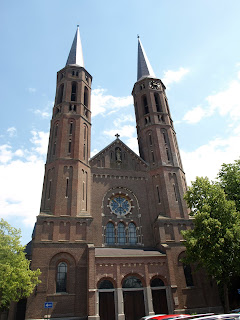Sunday, June 12, 2011
On The Rhine
Gen George Patton's Grave
The Cemetery
The Chapel
Inside the Memorial
Battle of the Bulge Memorial
Saturday, June 11, 2011
Hqtrs, 101st Airborne, Continued
Hqtrs, 101st Airborne at Bastogne
Ardennes Forest
Tribute To E Company, 2Bn 506 Regt
At One of The Points in the Star
Memorial To America At Bastogne
Friday, June 10, 2011
The Malmedy Massacre
The Battle of The Bulge Begins
The Dragon's Teeth At Aachen
Thursday, June 9, 2011
Arnhem, Holland
> The British 1st Airborne Division jumped the farthest into Holland to capture and hold the Arnhem Bridge over the Rhine until British 30 Corps could relieve them and gain a toe hold into Germany. It was a legendary heroic stand by the Pegasus Division but were ordered to withdrawal when British 30 Corps could not make it past Nijmegen before 1st Division ran out of ammo, food, water. Of the 10,000 airborne and gliderborne troopers who went in, only 2,400 escaped without being killed or captured. Thus, the Arnhem Bridge was a bridge too far. There is a wonderful airborne museum in Arnhem telling the story of this legendary battle; here's a picture at the entrance. While there we talked to a docent who was a 14 year old Dutch lad at the time of the battle and remembers it well. It was a real special experience to talk to him!
>
Maas-Grave Bridge
Memorial to E Co, 505th Reg, 82nd Airborne
Operation Market Garden .. Attacking the Bridges
Wednesday, June 8, 2011
Horsa Glider at Pegasus Bridge Museum
Rollin' Down the River
Moment of Truth
Between 1220 and 1250 the "judgement as the moment of truth" was placed above the central Cathedral door. This is the whole church gathered in everlasting joy: everyone united around Jesus.
At Notre Dame
Paris, We Have Arrived
Pegasus Bridge
Tuesday, June 7, 2011
Pointe Du Hoc
C-47 Dakota Fly-by
American Cemetery Overlooking Omaha Beach
Another View, Omaha Beach
We Have Landed, Omaha Beach
Monday, June 6, 2011
Battle Site of the 82nd Airborne
Guns At Longues-Sur-Mer
The Infamous Catholic Church in St Mare Eglis
Sunday, June 5, 2011
We Have Landed
101st Airborne Division Memorial, Brecourt Manor, Normandy
B-26 Maurader
Saturday, June 4, 2011
Embarkation From England
Tomorrow morning early (up at 5 AM) we cross the channel to Cherbourg and go to Utah Beach. Two special events take place which we will describe in the next blog.
Friday, June 3, 2011
Day 3 The Preparation.
We went down to the crypt and immediately entered the tomb of the Duke of Wellington. In the alcove of the tomb is a tribute to the British Field Marshals of WWII .. including Montgomery, Waverly, Alexander.
Next we went to the Imperial War Museum and visited the WWII display. It was very impressive with many original documents such as Eisenhower's message to the troops on D-1, the Top Secret minutes of the staff meeting just prior to D-Day, Rommel's death certificate and Hitler's Poland Invasion Directive with his signature.
Lastly we visited the Cabinet War Rooms and Churchill Museum as it was set up and utilized during the war, from 1939. Especially impressive were the many Churchill speeches that you could listen to while touring the museum. The picture here is Fred with our London Guide, a retired British cold war pilot and wonderful historian.
Tomorrow we are off to Portsmouth, one of the points of embarkation for the D-Day landings.
Wednesday, June 1, 2011
London Palace Guards Museum
Saturday, May 28, 2011
Our Start, Saluting Our Veterans
Tuesday, May 24, 2011
D-Day To The Rhine - The Beginning
We travel to Portsmouth, where we'll visit the award winning D-Day Museum and Overlord Embroidery. Portsmouth’s D-Day Museum is Britain’s only museum with the primary goal of covering all aspects of the D-Day landings in Normandy on June 6, 1944. The centerpiece of the museum is the Overlord Embroidery, the world’s longest embroidery of its kind, which measures 272 feet long. After lunch, the group will visit the Southwick House, the elegant country house which became the location of the Supreme Headquarters Allied Expeditionary Force. In the months leading up to D-Day, Southwick House became the headquarters of the main Allied commanders. Large wall maps that were used in planning D-Day are still in place in the house, with markers showing the positions of the involved forces at the moments of the first landings.
On the way to Paris we’ll view the Bridge at Troarn, the D-Day objective of the 3rd Parachute Squadron, Royal Engineers. We arrive in Paris in the afternoon and spend the rest of the day exploring the city.
We will drive to Bastogne where the Americans rallied and stopped the German attack. Here is the route of the initial American retreat and the place where the 101st Airborne and elements of the 10th Armored held off fifteen German divisions for eight days. Our historian will take us through the sites in the picturesque town. We’ll also see the Memorial to the troops and the Battle of the Bulge Museum nearby.













































